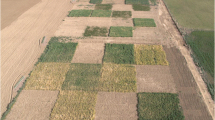Abstract
Crop phenological parameters, such as the start and end time of the crop growth, the total length of the growing season, time of peak vegetation and rate of greening and senescence are important for planning crop management and crop diversification/intensification. Multi-temporal remote sensing data provides opportunity to characterize the crop phenology at regional level. This study was conducted during the kharif season of the year 2001–02 for Punjab. The ten-day Normalised Difference Vegetation Index (NDVI) composite products, with 1 km spatial resolution, available from the Vegetation sensor onboard SPOT4 were used for the study. Twenty-one temporal datasets from May 1, 2001 to November 21, 2001 were used. Logical modelling approach was followed to compute the minimum and maximum NDVI, the amplitude of NDVI, the threshold NDVI during sowing and harvest, the crop duration, integrated NDVI and skewness of profile. The analysis showed that before July beginning, in the whole of Punjab, sowing/planting was over. It was found that the crop emergence in the eastern part of the state started earlier than the western region. The maximum NDVI, which represented peak vegetative stage, was above 0.7 and occurred mostly during August. The duration of crops ranged between 90–140 days, with majority between 110–120 days. Total integrated NDVI in Punjab was generally above 60. Using principal component analysis and divergence analysis seven best metrics were selected for crop discrimination.
Similar content being viewed by others
References
Badhwar GD (1984) Automatic corn-soybean classification using landsat MSS data: II. Early season crop proportion estimation. Remote Sens Environ 14: 31–37
de Fries R, Hansen M and Townshend J (1995) Global discrimination of land cover types from metrics derived from AVHRR pathfinder data. Remote Sens Environ 54: 209–222
Jensen JR (1996) Introductory digital image processing: A remote sensing perspective. Prentice Hall, New Jersey, p 316
Kaduk J and Heimann MA (1996) Prognostic phenology model for global terrestrial carbon cycle models. Climate Res 6:1–19
Lenney MP, Woodcock CE, Collins JB and Hamdi H (1996) The status of agricultural lands in Egypt: The use of multi-temporal NDVI features derived from landsat TM. Remote Sens Environ 56:8–20
Lloyd D (1990) A pheonological classification of terrestrial vegetation cover using shortwave vegetation index imagery. Int J Remote Sens 11:2269–2270
Panigrahy S, Ray SS, Sood Anil Patel LB, Sharma PK and Parihar JS (2003) Cropping system analysis of Punjab state using remote sensing and GIS. Scientific Note. RSAM/SAC/CS/SN/04/2003. Space Applications Centre, Ahmedabad
Rahman H and Dedieu G (1994) SMAC: A simplified method for atmospheric correction of satellite measurements in the solar spectrum. Int J Remote Sens 15: 123–143
Ray SS, Pokharna SS and Ajai (1999) Cotton yield estimation using agrometeorological model and satellite derived spectral profile. Int J Remote Sens 20:2693–2702
Ray SS, Sood Anil Panigrahy S and Parihar JS (2005) Derivation of indices using remote sensing data to evaluate cropping systems. J Indian Soc Remote Sens 33:475–481
Reed BC, Brown JF, Vanderzee D, Loveland TR, Merchant JW and Ohlen DO (1994) Monitoring phenological variability from satellite imagery. J Vegetation Sci 5: 703–714
Sakamoto T, Yokozawa M, Toritani H, Shibayama M, Ishitsuka N and Ohno H (2005) A crop phenology detection method using time-series MODIS data. Remote Sens Environ 96:366–374
Samson S (1993) Two indices to characterize temporal patterns in the spectral response of vegetation. Photogrammetric Engg Remote Sens 59:511–517
Sivakumar MVK (1988) Predicting rainy season potential from the onset of rains in Southern Sahelian and Sudanian climatic zones of West Africa. Agric Forest Meteorol 42:295–305
Stibig HJ, Beuchle R and Gond V (2000) vegetation data for regional forest cover mapping of Southeast Asia. Workshop on Vegetation 2000 Belgrade, April 3–6
Townshend JRG, Golf TE and Tucker CJ (1985) Multispectral dimensionality of images of normalized difference vegetation index at continental scales. IEEE Trans Geosci Remote Sens 23:888–895
Tucker CJ, Elgin Jr JH, McMurtrey III JE and Fan CJ (1979) Monitoring corn and soybean crop development with hand-held radiometer spectral data. Remote Sens Environ 8:237–248
Wang Q and Tenhunen JD (2004) Vegetation mapping with multi-temporal NDVI in North Eastern China Transect (NECT). Int J Appl Earth Observ Geoinformation 6: 17–31
White MA, Thornton PE and Running SW (1997) A continental phenology model for monitoring vegetation responses to interannual climatic variables. Global Biogeochem Cycles 11:217–234
Xin J, Yu Z, Leeuwen L van and Driessen P M (2002) Mapping crop key phenological stages in the north China plain using NOAA time series images. Int J Appl Earth Observ Geoinformation 4:109–117
Zhang X, Friedl MA, Schaaf CB, Strahler AH, Hodges JCF, Gao F, Reed BC and Huete A (2003) Monitoring vegetation phenology using MODIS. Remote Sens Environ 84:471–475
Author information
Authors and Affiliations
Corresponding author
About this article
Cite this article
Upadhyay, G., Ray, S.S. & Panigrahy, S. Derivation of crop phenological parameters using multi-date SPOT-VGT-NDVI data: A case study for Punjab. J Indian Soc Remote Sens 36, 37–50 (2008). https://doi.org/10.1007/s12524-008-0004-4
Received:
Accepted:
Published:
Issue Date:
DOI: https://doi.org/10.1007/s12524-008-0004-4




